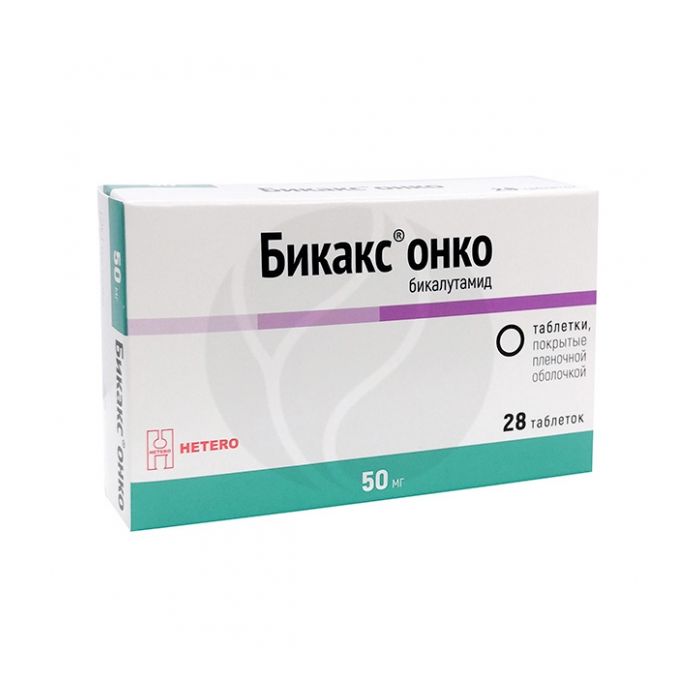Bikaks onco tablets p / o 50mg, No. 28
Expiration Date: 05/2027
Russian Pharmacy name:
Бикакс онко таблетки п/о 50мг, №28
Prostate cancer - as part of combination therapy with a GnRH analog or with surgical castration.
The method of application and dosage regimen of a particular drug depends on its form of release and other factors. The optimal dosage regimen is determined by the doctor. It is necessary to strictly observe the compliance of the used dosage form of a particular drug with the indications for use and the dosage regimen.
Individual, depending on the indications and treatment regimen.
Film-coated tablets
1 tab.
Active ingredient: bicalutamide - 50 mg
Simultaneous reception with terfenadine, astemizole, cisapride;
childhood,
hypersensitivity to bicalutamide.
Not prescribed to female patients.
Clinical and pharmacological group: Antiandrogenic drug with antitumor activity
Pharmaco-therapeutic group: Antineoplastic agent, antiandrogen
pharmachologic effect
Antiandrogenic non-steroidal drug. By binding to receptors that have an affinity for androgens, it suppresses the activity of androgens, as a result of which a regression of the prostate tumor is observed. Does not possess other types of endocrine activity.
Pharmacokinetics
After oral administration, it is well absorbed from the gastrointestinal tract. Food intake does not affect bioavailability.
Plasma protein binding is 96%. It is extensively metabolized in the liver by oxidation and formation of glucuronide conjugates.
It is excreted in the form of metabolites in the urine and bile in approximately equal proportions.
Cumulation of bicalutamide in the body is possible.
Indications
Prostate cancer - as part of combination therapy with a GnRH analog or with surgical castration.
Dosage regimen
The method of application and dosage regimen of a particular drug depends on its form of release and other factors. The optimal dosage regimen is determined by the doctor. It is necessary to strictly observe the compliance of the used dosage form of a particular drug with the indications for use and the dosage regimen.
Individual, depending on the indications and treatment regimen.
Side effect
From the endocrine system: hot flashes, breast tenderness and gynecomastia, decreased libido.
From the digestive system: abdominal pain, diarrhea, nausea, vomiting, increased transaminase levels, jaundice, cholestasis.
From the side of the central nervous system: asthenia, depression are possible.
Dermatological reactions: alopecia, hair regrowth, itching, dry skin.
Others: hematuria.
Contraindications for use
Simultaneous reception with terfenadine, astemizole, cisapride;
childhood,
hypersensitivity to bicalutamide.
Not prescribed to female patients.
Application during pregnancy and lactation
Not prescribed to female patients.
Application for violations of liver function
Use with caution in patients with moderate and severe hepatic dysfunction. possible accumulation of bicalutamide in the body.
During the period of treatment, regular monitoring of liver function is required. If severe changes develop, it is necessary to stop taking bicalutamide.
Application in children
The drug is not prescribed for children.
special instructions
Use with caution in patients with moderate and severe hepatic dysfunction. possible accumulation of bicalutamide in the body.
During the period of treatment, regular monitoring of liver function is required. If severe changes develop, it is necessary to stop taking bicalutamide.
Drug interactions
When using bicalutamide for 28 days while taking midazolam, the AUC of midazolam increased by 80%.
With the simultaneous use of bicalutamide with cyclosporine or calcium channel blockers, potentiation or development of undesirable reactions is possible.
It is theoretically possible to increase the concentration of bicalutamide in the blood plasma when it is used simultaneously with inhibitors of microsomal liver enzymes, which may be accompanied by an increase in the incidence of adverse reactions.
In vitro studies have shown that bicalutamide can displace the coumarin anticoagulant warfarin from plasma protein binding sites.

